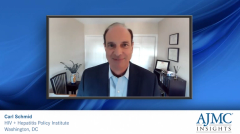
Enhancing Patient Education on PrEP Therapies
Drs Palella Jr and Milgram explains the disconnect between PrEP and patient education and comments on how to fix it.
Episodes in this series

Frank J. Palella Jr, MD: Measures that we undertake to positively reinforce a patient’s decision to initiate therapy, to keep them in care, to keep them following up, include this village of health care providers that I talked about: not just physicians, NPs [nurse practitioners], and PAs [physician assistants] but also nurses, pharmacists, front-desk workers, schedulers, social workers, and case workers. It has everything to do with providing an environment in which patients feel they’re undertaking something important for the maintenance of their health and the prevention of illness. That they’re taken seriously by other individuals in a welcoming environment where they feel as though they’re being listened to and respected, and that they can feel comfortable disclosing the most intimate details of their lives and will be responded to positively. That should challenges arise, including financial challenges regarding drug access, they will be responded to in ways that try to be resourceful and innovative. This is health care delivery just like health care delivery for other conditions.
However, we have the added social components of lifestyle, and unfortunately, we still have the potential stigma and discrimination that can occur for many people who are at the highest risk of HIV and who are in the greatest need of PrEP [pre-exposure prophylaxis]. Like our patients who are already being treated for HIV, the social situational aspects and dealing with the social determinants of health, including being able to address or refer to resources for things like mental health, substance use, stigma, poverty, housing, and security and the like are very important. You’ll get a very similar answer from most providers who take care of patients in this space.
We also have to be aware that some of the traditional risk groups that we talk about as being eligible for the receipt of PrEP aren’t always as inclusive. For example, it’s only recently that we started talking about cisgender women—particularly those who live in communities where the prevalence and incidence of HIV is greatest, even within the United States—being an important target and priority for PrEP awareness, PrEP initiation, and PrEP retention in care.
Access to injectable PrEP is getting better within the individual clinics, along with systems for streamlining the process of scheduling patients, getting them in for their injection, and dealing with acquisition of drug, including pharmacists and social workers to access either health care or pharmacy benefits through third-party payers. It’s important to be comfortable within the health care delivery system regarding the streamlined approach to seeing people every 2 months, reminding them of their visits, and undertaking STD [sexually transmitted disease] screening at the time of those visits for other non-HIV STDs, such as syphilis, gonorrhea, and chlamydia. Access is getting easier as more PrEP recipients and more clinics are availing themselves of long-acting PrEP. Long-acting PrEP is here to stay. We’re going to be seeing more patients and providers opting for long-acting PrEP in the first line for their appropriate PrEP-eligible patients.
Lynne H. Milgram, MD, MBA, CPE: We don’t have any barriers to treatment. We also have specialized clinics. We have areas that we feel are safe and protected with very skilled providers, including navigators. But as a health system, where we do such a good job in coordination of so many disease states, we just don’t do it here. We have case managers for patients with true AIDS, but we don’t have case managers or care coordinators looking at PrEP. We leave it up to the providers, and they’re specialized, but I don’t think we have good systems, either electronic or otherwise, that follow these patients. Some are lost to follow-up. Unfortunately, it isn’t an area that we’ve started to concentrate on.
Transcript edited for clarity.
Newsletter
Stay ahead of policy, cost, and value—subscribe to AJMC for expert insights at the intersection of clinical care and health economics.












































